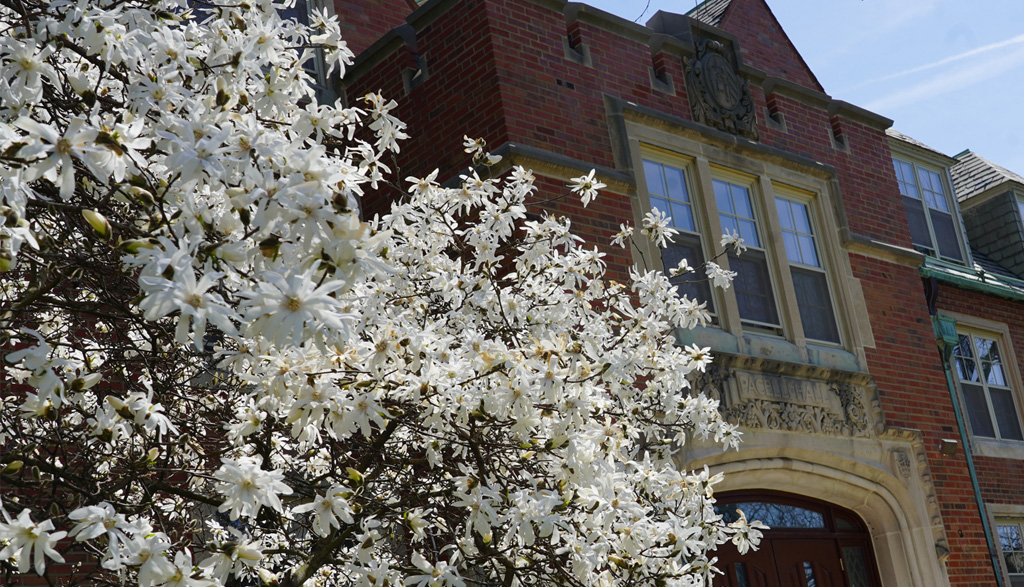Words and Thoughts of President Alan R. Miciak
Wishing You a Summer of Mindful Happiness

Imagine the author of a best-selling psychology textbook looking out at the world and sharing this observation: “voluntarily bringing back a wandering attention, over and over again, is the very root of judgment, character, and will.”
Could he have been pondering the 20 billion text messages (nearly 85 per person) sent between the world’s people each day? Or was he reflecting on the 2 hours and 27 minutes per day that the average person spends on social media? Or the 159 times a day the average American checks their mobile device?
That link would be obvious, except that William James, considered to be one of America’s first great psychologists, wrote his two-volume The Principles of Psychology in 1890, a century before the smartphone and internet, well before even the assembly line, rotary dial, and the zipper.
Time vs. Attention
In the 133 years since James’s publication, we have paid scant attention to the science of attention. In recent months, we’ve showered attention on the launch of generative machine learning tools such as ChatGPT.
When I ask ChatCPT “Who is Alan Miciak?” it asks for more clues. If I provide my employer and title, it retrieves some accurate biographical detail but goes on to misidentify me as a Notre Dame graduate and published researcher in inorganic chemistry.
Such are the risks in the early, uncertain age of human/computer collaboration. Some predict wondrous applications. Others warn of unintended consequences and catastrophes. Whether our first response is to run toward or away, change has arrived.
Summer of Change
Into this uncertain time go our matriculating and graduating students … leaving the well-defined boundaries of John Carroll University’s campus for an endless summer of possibilities.
Many will step into new careers, or complete paid internships, as data scientists and corporate communicators. Some will pursue research, on campus and offsite at the Cleveland Clinic, Tier 1 research institutions, and elsewhere. Others will return home to work as a Metroparks lifeguard, to help run the family farm, or contribute to a relative’s accounting practice.
You won’t have to look very hard to find the artificial/collaborative intelligence revolution within reach. Most hospitals use some form of predictive tool to do things such as measure uneven aneurysms or flag subtle shifts in vital signs. Farmers in Ohio and elsewhere increasingly rely on cloud-enabled tools to autonomously steer tractors and gauge seed depth.
What will collaborative intelligence ultimately mean for progress in speeding drug discovery, monitoring ocean reefs, ending human trafficking, or ensuring the survival of threatened species — including our own?
As a place of higher education, how will we reimagine the very nature and limits of human intelligence? Will we do right by students who will soon be responsible for making the tough choices that accompany this new technological age? And can the habits of attention play a role?
A More Inspired Future?
Interestingly, in a different corner of science, neuroscientists like Richard Davidson take a closer look at purely human-to-human collaboration and partnership. Davidson and his colleagues use state-of-the-art imaging tools to better understand how human connection (kindness, empathy, love) — rewires the brain for attention and learning.
If the psychologist Williams James is right, that “voluntarily bringing back a wandering attention, over and over again, is the very root of judgment, character, and will,” neuroscientists like Davidson suggest that such a habit may be more within our reach and more closely tied to emotion than we imagine.
Davidson said this in a recent podcast interview: “The brain does not honor the kind of anachronistic distinction between thought and feeling. Thought and feeling are absolutely intermingled in the brain, and so there are no areas of the brain that are exclusively dedicated to one and not the other.” He adds that adversity — triggered by a tough exam or a prolonged pandemic — not only “gets under the skin,” but into the brain’s wiring as well, impairing cognitive and emotional function simultaneously.
So, within the context of the classroom and campus more broadly, how we might cultivate the habit of attention — along with complementary tools such as empathy, compassion and kindness — as a natural counterbalance to growing human/computer interdependence?
Davidson’s research confirms that it mostly requires modeling and practice. “The very mechanisms in the brain that allow adversity to get under the skin also enable awakening. We can harness this power of neuroplasticity for the good by cultivating certain kinds of virtuous qualities. Neuroplasticity, in itself, is neutral.”
Just as we learn language through immersion and affirmation Davidson’s research shows the same process works on other fronts. “If we’re in a context where people are doing kindness around us, we will osmotically absorb it, and it will be nurtured.”
Love, Actually
In the Middle Ages, 1,500 years before ChatGPT or smartphones, the Roman philosopher Anicius Manlius Severinus Boethius wrote this sentence, “O happy race of mortals, if your hearts are ruled as is the universe, by Love.”
It’s not easy to maintain that perspective — such radical hope — at a time when the world seems hellbent on communicating mostly fear and anger. Maybe we sell ourselves short when we take a mostly cognitive stance (our comfort zone as educators) and advocate for tolerance.
The Dalai Lama challenges us to think about our willingness to show love and kindness through the lens of biased and unbiased compassion. Biased compassion, he argues, is compassion toward your in-group. Unbiased compassion is compassion toward all beings.
Davidson warns that no matter how high our minds might try to reach — aided or unaided by algorithmic tools — real progress and personal success will ultimately be decided by whether we bring our bodies along for the journey. “If it’s just cerebral, it will never be genuine,” he says. “There’ll be a disparity between what we espouse cerebrally, cognitively, and what our bodies are saying.”
Resilience and Attention
Davidson and his colleagues at the Center for Healthy Minds at the University of Wisconsin–Madison have studied resilience for more than three decades. He says: “Resilience in a hard-nosed research context is the rapidity with which you recover from adversity. To paraphrase the bumper sticker, stuff happens. We can’t buffer ourselves; that’s the nature of life. What really is important is how we relate to these challenges.”
Self-regulation sits at the center of Davidson’s work with K-8 schools, teachers, and children. When kids in preschool classrooms lie on the floor with a little stone on their belly, they pay closer attention to their breathing, and this simple exercise changes brain circuits of attention and leads to improvements in standardized, objective measures of attention.
Davisdson’s group helps children learn to deploy these strategies as a way to self-regulate. “If something comes up and they can actually pay attention to what’s going on in their body,” he says, “rather than getting swept up in the immediacy of the emotions, and in that way, they can both strengthen their attention and they can regulate their emotions.”
And if we can come back to baseline more quickly, that is powerful. Not only does it have consequences for our psychological well-being, but it also has consequences for our physical health.”
Davidson adds: “Our attention tends to be hijacked by salient stimuli in our environment. Our attention is stimulus-driven. It’s pulled; it’s grabbed. The invitation here is that we can be the rudder of our own mind, if you will, and steer it, direct it where we would like it to be directed by strengthening our capacity to voluntarily deploy our attention.”
During a four-year college experience, we invest a lot of time and energy toward the goal of graduating young adults into a world that will pull and grab at them like no world we have ever known.
Educator and writer Robert Harris says this about the value we try to impart.
“Good judgment requires the ability to think independently, in the face of pressures, distortions, and overemphasized truths. The tools of examination and analysis that you will learn to use, will enable you to develop your own opinions, attitudes, values, and beliefs, based not upon the authority of parents, peers, or professors, and not upon ignorance, whim, or prejudice, but upon your own worthy apprehension, examination, and evaluation of argument and evidence. While a liberal arts education may not teach you how to take out an appendix, it will teach you how to think, which is to say, it will teach you how to live.”
A lyric from the 1935 opera Porgy and Bes s says: “Summertime and the living is easy.” Human/computer collaboration is already easing aspects of our professional and personal lives. At the same time, it’s complicating our relationship with each other and our own minds, bodies, and motivations.
A little daily practice at “voluntarily bringing back a wandering attention, over and over again” will do us all some good. Something tells me that we will need all the good judgment, strong character, and persistent will that we can muster in the coming years.

